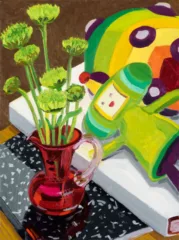This week’s Weekly has my review of Pay to Play, the guest-curated show at Black Floor Gallery. Below is the copy and here’s the link to the art page.
Here Comes the Bribe
Black Floor’s “Pay to Play” show is topical but shallow.
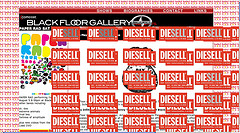
Albo Jeavons’ “corporate” takeover of the Black Floor website. Beware of going to the website because it may freeze your computer. I got in and out on my mac but others have had trouble.
The basic requirement to get into the “Pay to Play” show at Black Floor was the artists had to offer creative bribes to the curator. With that call to arms, it’s no wonder the show is full of works about money, marginalized populations and sleaze. It’s a shame more artists didn’t have fun with it.
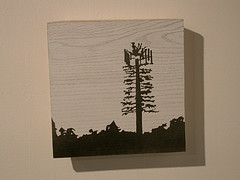
Adam Eckstrom’s silhouetted cell phone tower tree, painted on wood panel. The work is a lovely portrait of an unlovely thing pretending to be what it’s not.
Mostly—although there are exceptions in works by Albo Jeavons, Charles Hobbs, Lizz Wasserman and Lucas Blalock—the 15-artist show has so many lead-footed political statements that it’s the visual equivalent of “Just Say No”: a little bit pat and low-energy.
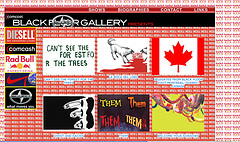
The Scorn icon (Scion) moves around like a shark fin in front of the Gallery’s logo.
For all the artists’ well-meaning efforts about pornography, self-image, terrorism, cell-phone towers, homelessness and urban gentrification, much of the content is thin and even a little generic.
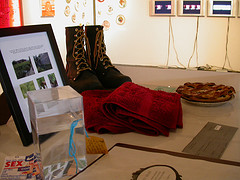
The bribe table, including embroidered towels, boots, gift certificates, photo-documentation of a tree planting, stickers, some water, an apple pie and more.
I don’t doubt the sincerity of any of the works. What I wonder is how personally engaged some of the artists are with the subjects and whether—and this is how it felt in places—these pieces are cause-of-the-day toss-offs instead of works that come from a deeper place.
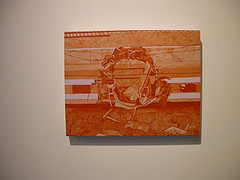
Mauro Zamora’s painting of an explosion hole ripped into what looks like a train (perhaps a reference to those bombings of the Spanish railway?). Another lovely work portraying contemporary horror.
The exceptions are those artists whose works are either more nuanced or more high-spirited, or both.
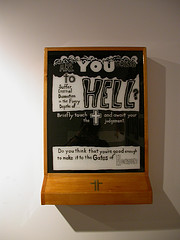
Charles Hobbs’ interactive piece. Touch your fingers to the metal cross on the bottom of the wood panel and the piece flashes either “heaven” or “hell” in the black area above. It didn’t work for me but the show’s guest curator Amy Adams’ had the right touch and the piece told her she’s going to Hell.
Albo Jeavons’ art would stand out in any crowd. The local artist is well known for his anticorporate, antiracist installations that have appeared at Nexus, Space 1026 and Klein Gallery, as well as on the city streets. Jeavons is represented here by one of his trademark 3-D cartoon figures, but his more telling mark on the show isn’t visible in the gallery. Jeavons staged a mock corporate takeover of Black Floor’s website. Go there and see the annoying parody pop-up ads for corporations like Comcash, DieSell, RadBull and Scoro (for Scion). This spot-on intervention demonstrates in one fell click the money-equals-power equation, and does so with more panache and sense of mischief than anything else in the show. (Although Black Floor did grant permission for the website takeover.)
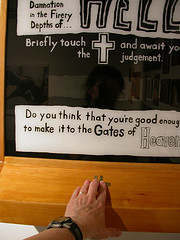
I love interactive art. And this piece is beautifully made and has just the right mix of carnie barker and religion to be very smart about both.
Other nuanced, high-spirited works are Charles Hobbs’ Are You Going to Hell? interactive game, Lizz Wasserman’s drawings of celebrities on commemorative plates salvaged from thrift stores, and Lucas Blalock’s digital C-print American Standard, which shows a man trying to pull himself up by his bootstraps.
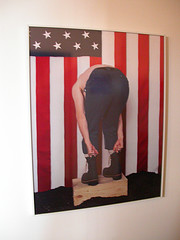
Lucas Blalock’s guy pulling himself up by his bootstraps. Of course he’s mooning you, too.
The bribe table (too bad the loot wasn’t put “under” the table) includes an apple pie, an invalid gift certificate, and the photo-documentation of a tree-planting. I wish the bribes taken had been dirtier—like real money or real payola. But that’d be a different show.
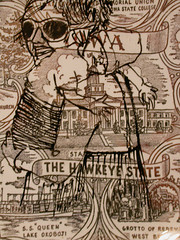
Detail of one of Lizz Wasserman’s commemorative plates bearing her drawings of celebrities. I like how the drawing almost disappears here, and how the whole thing is grey and ghostly, a comment on fleeting fame and fleeting memories.
Political art needs to be made with gusto and created with head and heart. When it is, experiencing it can be transformative. Artists like Pepón Osorio, Sarah McEneaney, Jane Irish, Mark Shetabi, Andrea Fraser, Rirkrit Tiravanija, Komar and Melamid and Cindy Sherman—to name just a few—make works not only politically engaged, but “soul works” that come from the artists’ cores. The mix of personal and political can make this art unforgettable instead of merely topical—the category into which I’d put much of the work in this show.
“Pay to Play”
Through Aug. 27. Black Floor Gallery, 319A N. 11th St., third fl.


